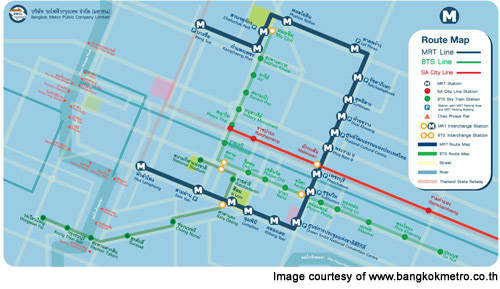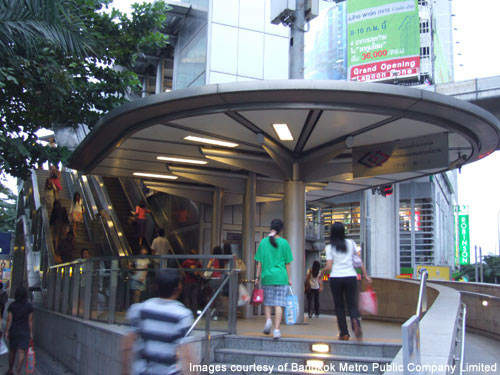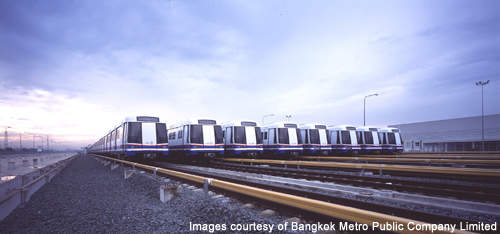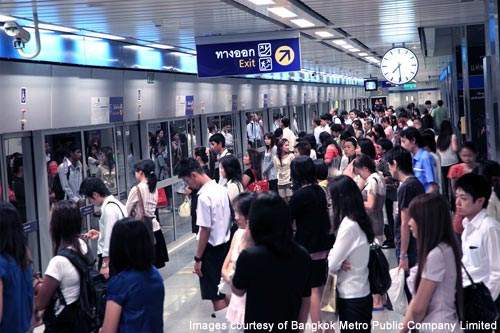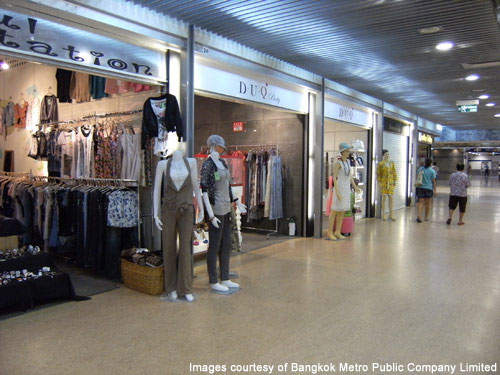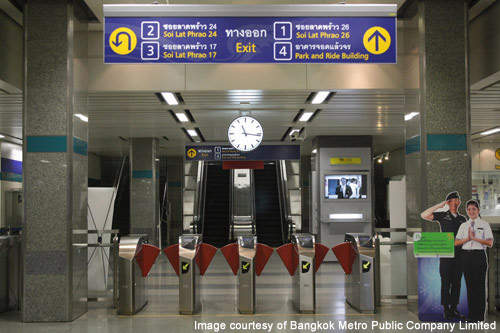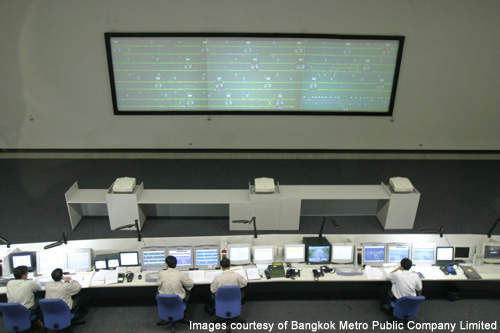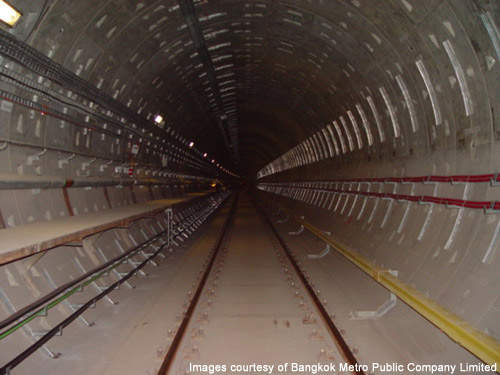Bangkok Metro is the underground metro rail system of Bangkok city in Thailand. It is officially known as the Mass Rapid Transit (MRT) and is a part of the Bangkok Rail Transit Network (BRTN).
The other transport systems of BRTN include the Bangkok Mass Transit System (BTS Skytrain) and the State Railway of Thailand (SRT).
The MRT is 20km long and extends from Hua Lamphong railway station to Bang Sue railway station. An average of 2,00,000 passengers ride on these trains each day.
Bangkok Metro Public Company Limited (BMCL) won the concession contract for a 25-year period and was handed control after Mass Rapid Transit Authority of Thailand (MRTA) provided the civil infrastructure.
MRTA is the owner of the project and BMCL is the operator.
The project
Construction of the Bangkok Metro began on 19 November 1996. It suffered delays because of the 1997 economic crisis and faced many civil engineering challenges in constructing underground structures. The metro system is also popularly called the Blue Line.
The turnkey project was implemented by Siemens Transportation Systems, who completed it in 28 months. The scope of the contractual award made to Siemens included project management, system integration of electromechanical elements, supply of rolling stock (19 three-car metro trains along with power supply), signalling and telecommunication equipment, platform screen doors and complete signage, alongside operational training of staff and the supply of an automatic fare collection system, depot and workshop equipment.
Siemens was also obliged to provide operational support for one and a half years and servicing for ten years.
In April 2004 it was opened for a limited trial period for few weeks. Later, on 3 July 2004, the metro line was officially opened by HM King Bhumibol and Queen Sirikit.
On 17 January 2005 an empty train returning to the depot hit a running train with passengers at the Thailand Cultural Centre station, injuring 250 people. The complete network was closed for two weeks following the accident. On 1 February 2005, the Metro resumed its operations.
The MRT is a 20km-long 18-station underground rail transit system. It starts at the Hua Lamphong station crossing the Samyan intersection, Silom intersection, Lumphini and Khlong Toei stations, and turns left at Rama 4 intersection. Then it passes along the Queen Sirikit National Convention Center towards Asoke-Sukhumvit intersection, Asoke-Phetchaburi intersection, Rama 9 intersection, Huai Khwang intersection, and Sutthisan intersection turning left to Lat Phrao road at Ratchada-Lat Phrao intersection.
After reaching the Lat Phrao intersection, it crosses the Phahon Yothin road, Chatuchak Park, Mo Chit Northern Bus Terminal (Old), and turns right to Kamphaeng Phet road. It then passes along the Marketing Organization for Farmers (MOF) market, ending finally at the Bang Sue Railway Station.
Infrastructure
There are 18 subway stations in total. The distance between each station is approximately 1km.
Stations are built approximately 18m below ground level. The average area of each station is 23mx200m. The number of levels within each station differs according to the limitations of the building area.
Retail area level
This is the first level of those stations that have space available for retail shops. Passengers can visit the retail area level without being required to pay a fare.
There are 11 stations that have a retail level: Khlong Toei, Queen Sirikit National Convention Centre, Sukhumvit, Phetchaburi, Phra Ram 9, Thailand Cultural Centre, Ratchadaphisek, Lat Phrao, Phahon Yothin, Chatuchak Park, Kamphaeng Phet. The basement area of the MRTA park and ride facility at Lat Phrao station also has retail space.
Concourse level
For stations that do not have a retail level, the concourse level is the first level. For stations with a retail level this is the next level down. The ticket office, station operation room and route maps are located on this level.
Platform level
This is the lowest level and is where the train stops for passengers to embark and disembark. A glass wall, with platform screen doors (PSD) that cover the full height of the platform, lies between the platform and the track. When the train stops at the platform, the PSDs open and close automatically along with the doors of the train.
This safety system not only prevents passengers from falling onto the track but also helps to conserve energy by maintaining the air-conditioned temperature within the station. In addition, there are three types of platforms within the Bangkok MRT System:
Central platform
Trains run along the sides of the platform, with inbound trains on one side and outbound trains on the other side. The width of the station is about 21–25m. There are 13 stations with central platforms: Hua Lamphong, Oueen Sirikit National Convention Centre, Sukhumvit, Phetchaburi, Phra Ram 9, Thailand Cultural Centre, Huai Khwang, Sutthisan, Ratchadaphisek, Lat Phrao, Phahon Yothin, Chatuchak Park and Kamphaeng Phet stations.
Side platform
Trains run in the middle of the platforms, which are separated by inbound and outbound trains. The width of the station is about 28.50m. Khlong Toei and Bang Sue station are the two stations with side platforms.
Stack platform
This type of platform structure is used where the area for construction of the station is insufficient. Due to limiting physical conditions, the width of a station can only be18m. There are three stations with stacked platforms: Sam Yan, Si Lom and Lumphini station.
Rolling stock
The MRT operates 19 three-car metro trains with two motor cars and a centre trailer car. The rolling stock can accommodate 900 passengers in each train, with driving cab and emergency exits at each end car. Each train is provided with two fire extinguishers, while the driving cab has one.
Every car has a seating capacity of 42 passengers with two wheelchair spaces. Each car has a passenger intercom push button on alternate sides for emergency communication with the train operator.
Signalling and communications
The signalling and communications of the Bangkok Metro line are monitored by the Operations Control Center. It controls and commands the whole system including the stations and trains. In emergency cases, to have continued smooth train service, the control and command can be regained from the Playback and Training Room. It operates 24 hours, supporting train services and maintenance activities after service hours.
The future
Bangkok is planning expansion of its metro system. The lines are expected to extend to a total length of 487km, covering the major areas of the city. The BTS Sukhumvit Line, BTS Silom Line and the MRT Blue Line had been constructed by 2009.
The other projects under construction include the Airport Link; MRT Purple Line; BTS Dark Green Line; BTS Light Green Line and SRT Red Line. Other lines in the planning stages are the MRT Blue Line Extension; MRT Orange Line; SRT Dark Red Line; SRT Light Red Line; MRT Yellow Line; MRT Grey Line; MRT Pink Line; and MRT Black Line.

